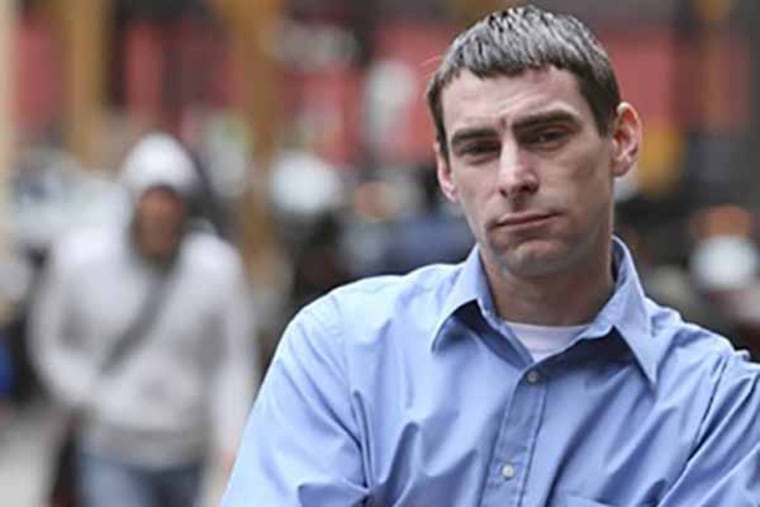An ex-skinhead urges tolerance instead of hate
He warns teens to avoid the violent world he once craved.

Frank Meeink grew up in South Philadelphia three decades ago, but he never met a racist skinhead until he visited his cousin in Lancaster in 1989.
He watched his cousin and his friends pound mercilessly on victims at a concert and saw the fear they stoked in others. A vulnerable 13-year-old with a rocky home life, Meeink was drawn into their violent world.
He threw himself into the neo-Nazi scene. By 15, his head was shaved, acts of violence were second nature, and he sported a large swastika tattoo on his neck. At 17, he was jailed in Illinois for kidnapping and torturing a rival skinhead.
"I was primed for hate when I met these guys," Meeink, 38, said in an interview as he prepared to tell his story this week to hundreds of Chester County students. "Now, I think about all the kids out there who were just like me, and how easy it is to be exposed to these ideas."
Pennsylvania was once believed to harbor more active neo-Nazi and white supremacist groups than any other state in the East, and is still a haven for such groups, advocates say.
This weekend marks the annual Philadelphia gathering for Pennsylvania's largest group, the Keystone State Skinheads. The organization celebrates Leif Erikson Day by meeting at the statue next to Kelly Drive that commemorates the Norwegian explorer, believed to be the first European to land in North America.
But these days, teenagers don't have to leave home - the Internet makes it easier than ever for recruiters to connect with potential targets.
The rise of the Internet is also a factor in what advocates say is a resurgence in skinhead activity over the last six years.
The election of President Obama, a troubled economy, a spotlight on immigration issues, and booming antigovernment and militia groups have created a perfect storm for rekindling racist groups, said Anthony Griggs of the Southern Poverty Law Center, a nonprofit civil-rights group based in Alabama.
"A few years ago, skinheads would meet in basements or back alleys," he said. "Now they are masters of the Internet in using it to regroup and promote their ideology."
In Pennsylvania, a handful of recent incidents have been linked to hate groups. In August, Ku Klux Klan fliers were distributed in Reading, accompanied by a suspicious object that triggered a bomb scare. A week later, similar leaflets were distributed in an Allegheny County town, said Shannon Powers of the state Human Rights Commission.
This month, a Maryland-based Ku Klux Klan group planned a rally at Gettysburg National Military Park, but it was canceled due to the government shutdown.
Other incidents have highlighted ethnic and racial tensions, such as a 14-year-old student at Perkiomen Valley High School in Montgomery County, who in March was charged with drawing swastikas on another student's papers.
Between 2006 and 2012, violent hate crimes and the numbers of people who identify themselves as racist skinheads rose, according to the Anti-Defamation League. Last year, the Southern Poverty Law Center found that hate groups remained at a near-record level - 1,007 nationwide, 35 with activity in Pennsylvania.
The local groups are not as visible as they once were, Griggs said. Just two known racist skinhead groups are active in the state, he said.
"Pennsylvania has a large population, and a history of manufacturing jobs," he said. "A lot of these guys see themselves as hardworking, blue-collar people. And the current national climate has stirred up a lot of them."
Meeink is still heavily tattooed, but he has had the racist emblems that once adorned his neck and hands lasered off or covered by other tattoos. He has worked with the Anti-Defamation League for close to 20 years, spoken at schools nationwide, authored a memoir as a "recovering skinhead," and founded a hockey program for at-risk youths.
"I was a cowardly person," Meeink told the students at Oxford Area High School, which invited him to speak. "I feared my stepfather, I feared my school, I was afraid of not having enough to eat."
His speech there Tuesday was one of two area lectures. The other was at the National Museum of American Jewish History on Independence Mall.
Meeink said he became a well-known skinhead who recruited other teenagers, sometimes with fliers at schools and eventually with a cable access show in Illinois called The Reich.
When he met his cousin's friends in Lancaster, they were interested to hear he attended school with people of other races.
"My parents never said to me, 'Hey, how was your day?' " Meeink said. "When these guys would ask what Philly was like, it was like someone saying, 'What's your life like?' "
But in prison, Meeink forged friendships with several young black inmates, finding that he had more in common with them than with Aryan gang members. Upon his release about a year later, he was hired for his first job by a Jewish man who encouraged his sense of self-worth and potential.
The final piece fell into place when he started reading about advances in DNA technology, he said, and learned that there were no differences between races.
"I realized, these guys aren't writing this to prove me wrong," Meeink said. "It was all there for me to see - I'd been banging my head against a wall trying to make myself believe this other stuff, believe that these people were my enemies."
610-313-8113
@AESteele